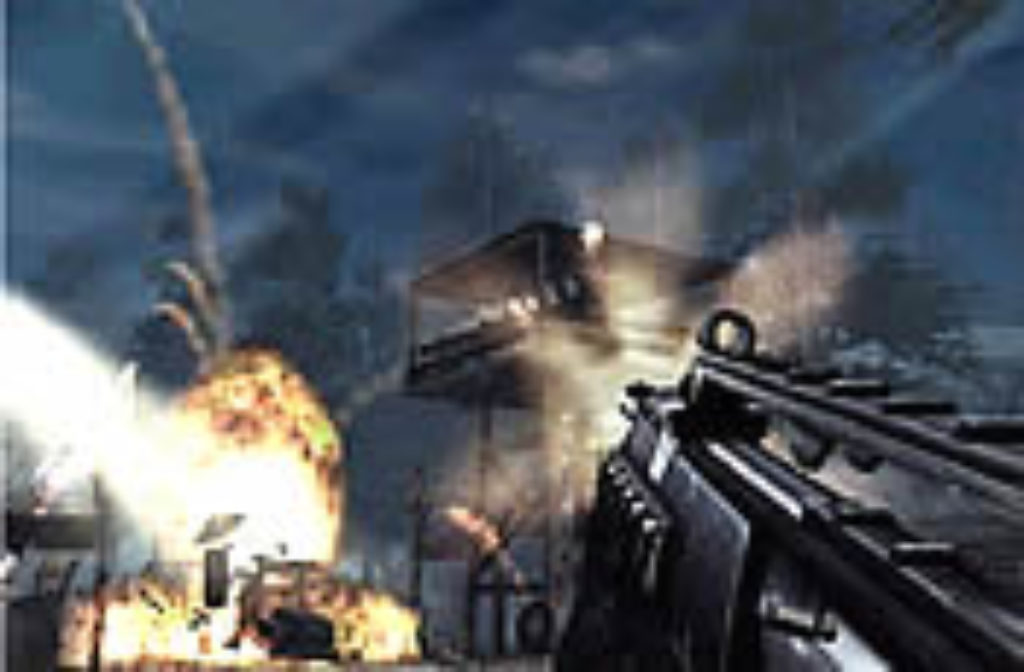
I’m guessing the offices of Criterion Studios house enough testosterone to warrant at least one conference room solely dedicated to blowing off steam. I picture twenty- and thirtysomething men putting each other in half nelsons during their lunch break or igniting a Coke can full of some nitrate explosive mixture … just for kicks.
What else can explain the video game developer’s obsession with re-creating a demolition derby in its latest first-person shooter, Black?
Not that massive blasts and intense action are anything new for Criterion, which gained its macho reputation via the high-speed street-racing Burnout franchise. In those games, the better the motor, the bigger the metal-crunching pileup of multiple automobiles. With Black, it’s basically the same thing, only this time the bigger the weapon, the better the kaboom.
Just Like Your Older Brother’s Video Game
In recent years we’ve seen the classic first-person shooter game morph into a multifaceted adventure. Some projects have included elements of role-playing games. Others have emphasized the element of strategy. Still others, such as Halo, have tossed in story lines worthy of big-screen productions.
You can forget all that fancy-schmancy stuff with Black. As “pure” a first-person shooter as they come, this project clearly puts bang-bang first, story waaay last—though Criterion creative director Alex West begs to differ. “There’s no point in doing a mindless shooting and blowing-stuff-up game,” he says. Citing TV cult faves such as Alias, 24 and Prison Break as inspirations, West says he and his team were aiming for something “very iconic, very current, very now. There [are] a lot of references in the game that are happening in the real world. We’ve always wanted Black to be very credible, very believable and very authentic. … The game is about serious, real issues. A lot of people aren’t aware of that.”
Exactly my point. Those who are “unaware” are the very ones playing this game … and trying to figure out what in the world it’s really about. So for the sake of everyone being on the same page, here’s what is decipherable:
Playing as Sgt. Kellar, you’re an elite agent for Black, a clandestine special-ops group. They take orders from no one—which is just how the American government likes it. As a result, certain global “assignments” can be executed using whatever means necessary.
As the game begins, you face a merciless Fed who’s interrogating you on your knowledge of a terrorist unit called Seventh Wave. Turns out the group’s leader, Lennox, is an ex-Black who’s now involved in some good ol’-fashioned arms dealing. Apparently, your task of snuffing him out went south at some point, though it’s hard to tell exactly when through all the co-op mumbo jumbo. Yet more muddled information gets spread across cut scenes that segue into the game’s eight main operations, each of which recount Kellar’s Eastern Europe dealings.
Skip the Story, Grab Your Gun
Not that any of that matters. Your primary mission here? To blow things up. And when they’re completely obliterated, blow them up again, just for the fun of it. And then find a stray RPG and, hey, why not go for one more fantastic smoke-filled go-round?
Each level ups the ante with a new arsenal of weapons, an equally intimidating batch of enemies and increasing intensity. Yet what’s most intriguing about this game is that despite its shallow premise and story, the gameplay alone keeps you glued to the screen, like it or not. Criterion has created a realistic environment in which every bullet fired has a lasting ripple effect. Add to that a blockbuster movie-like soundtrack, stunning graphics and audio that captures every emptied shell crunching under your feet.
Real-World Realism
Clearly, these guys know what they’re doing. But first-class gameplay doesn’t equate to a first-class game, at least when it comes to morality. As if over-the-top explosions weren’t enough to steal the show, West and Co. decided to “get real” with lots of swearing (the f-word, s-word and “g–d–n” are liberally included) and ammo-riddled baddies who die loud deaths. There’s no bloodshed during play—something gamespot.com calls “downright silly” for M-rated fare—but cut scenes feature photos of real-life fatalities. And at its core, Black is founded upon straight-up murder excused (somewhat) by a sense of patriotism.
Other recent first-person shooters have shared the nationalism motif. But each has had distinct motives. Close Combat: First to Fight simulated the actual urban combat training model for the U.S. Marine Corps. SOCOM 3 emphasized the tactical warfare of Navy SEALs.
Not so with Black, which thrives solely on increasing the body count in as spectacular a fashion as possible—gore or no gore. That makes for an easy decision on whether to suit up with this elite strike force. As Kellar tells his interrogator, “There’s no way anyone in their right mind would volunteer for this.”